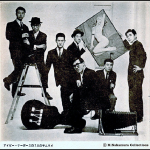
When it comes to classic Americana, the Japanese are meticulous in their research and sticklers for details — at least most of the time.
Nick Sullivan, Esquire‘s fashion director, lent me the latest addition to his style library: “The Ivy Pictorial Dictionary” by Toshiyuki Kurosu (who’s associated with the brand VAN, according to our man in Tokyo), from 1983. The illustrated pocket tome is curious for several reasons. For starters, it’s called an “Ivy” dictionary, yet includes listings for anything classic and American, including Harley Davidson, Jack Daniels, and Union Pacific Railway. For the letter I, the book includes the “Ivy League Model” suit, with a detailed description of what makes a suit Ivy, yet states that the three-button is the exemplary Ivy model, not the 3/2.
A friend translated the passage, coming up with this:
The kind of clothing we call “Ivy” is actually called “Ivy League Model.” Over there, if you say “Ivy,” people may think of Ivy League schools. Be careful.
The clothing has several distinctive features: natural shoulder, widely spaced three buttons (only the top two buttons are used), stitches around sleeves and the pockets, and hooked vent. Slacks are plain front, come with belt loops and back strap, and the silhouette is stove-pipe. These are the must-have characteristics.
It’s silly, but when I was young, I was so proud of myself for remembering all those details.
Evidently the Japanese can be rigid perfectionists when it comes to Ivy style, painstakingly recreating vintage styles, and then turn around and use the term “Ivy” quite loosely, as in the song “Ivy Tokyo“. You’d think the guy is singing about hooked vents and lapped seams, but the song is really about chasing girls.
“Men’s fashion wouldn’t exactly make a cool subject for a song,” said my friend. — CC












I notice a saddle shoe on the cover, but as I recall, you, Christian, hate saddle shoes.
Is this your idiosyncratic exception to your love and appreciation of everything Ivy, or is there something deeper going on?
P.S.: I noticed the sock garter too. What a wonderful contraption! I wish I could find comfortable ones.
Yes, I almost didn’t do this post because of those shoes. Even as I type this I have to look away from the screen.
Could we please see more pages from the book?
I love the outfits on the cover. Always tried and never managed to find a dark cognac coloured corduroy jacked (that i could afford).
wow. it’s so cute. sorta looks like a paper doll book.
The “Ivy League Model” is the exact name of an actual line of suit jackets/blazers that was sold at the Van/Kent stores in Tokyo. The 3-button model seems identical to the “Ivy League Model” described in the book.
Back-in-the day when I lived in Japan, my friends who claimed to dress “trad” always wore clothes that seemed be just a little over-the-top in my view (see Van’s “Ivy League Model” blazer for an idea of what I mean: http://allabout.co.jp/mensstyle/mensfashion/closeup/CU20050404A/index9.htm ).
Although their clothes were extremely well made, they did not have the casual nonchalance of traditional clothing that I had always admired in the US. Their look seemed over-simulated and planned — like a costume. I think that this was partly due to the effort required in order to associate the Japanese “trad look” with a an actual fashion statement, and differentiate it from the ocean of blazers, loafers and rep ties that are mandated as school uniforms all over Japan.
As has been noted by other commenters, some Japanese seem to have a voyeuristic (I’m tempted to say homophilic) approach to things Ivy (as attested to in “Take Ivy”). They also seem incapable of distinguishing between the general catgory “Americana” and the sub-category “Ivy”, as attested to by the “Ivy Pictorial Dictionary”.
I wonder if the Japanese are similarly amused by books produced by Western camp followers of things Japanese.
An appreciation for fashion and style is for the most part a “voyeuristic” pursuit, is it not?
That being said, I think that the Japanese are perfectly capable of differentiating between “general Americana” and “Ivy”. The Japanese term “Ivy” includes a specific sense of nostalgic reverie. The pictorial references to JFK and vintage automobiles in the book seem to support that definition.
“Americana” is much broader and not limited to the past tense. If you were to ask the modern Japanese person to describe American culture, I doubt that any of the images portrayed on the cover of this book would even make the list.
Based on my unscientific observations while living in Tokyo, I would guess that far more argyle socks are sold in Japan every year, than in the US. And far more Japanese (men and women) wear clothes that would typically be described as “conservative” or “traditional” than in the US. The Japanese are not voyeurs…they are very active participants.
But to try and hold Japanese “Ivy” fans to the American aesthetic that we might refer to as “Ivy Style” is an unfair expectation. Japanese “Ivy” is its own entity. As I expressed in a previous post, Japan’s “Ivy” is an over-the-top homage its American inspiration. It’s not meant to be accurate. It couldn’t be, because mainstream Japanese are already going to work dressed like they just stepped out of a Brooks Brothers catalog or taking the train to school wearing rep ties far before any American kid of the same age has even learned how a tie is tied. Our American “Ivy Style” would have very little chance of being any kind of fashion statement on its own in Japan. They had to “tart” it up a little just to be noticed.
And there are certainly fetishes parallel to Japan’s “Ivy” on this side of the Pacific. Americans wearing kanji tattoos and decorating their McMansions in “California Zen” from Pier 1 are similarly baffling to my Japanese friends. And have you ever been to Beni Hana?
Sorry, Lorenz.
I’m afraid the book isn’t worth the trouble of scanning. The rest of the images are simply black-and-white drawings like the Ivy League Model entry, not color, like on the cover.
It’s actually a pretty boring book, but if you’re really curious, you can probably find it on eBay, which is where this copy was found.
Fantastic stuff, I’d love to be able to lay my hands on a book like this – and to echo an earlier comment, it would be great to see more pages!
On the West Coast, in the 60s, those of us who wore Ivy League clothes, always buttoned the top two buttons on three button jackets when we buttoned-up our jackets. I’m quite sure they were manufactured that way, and appeared on mannequins in shop windows that way. I don’t remember seeing a 3/2 jacket. Does anyone else remember this? I must do some research and see if I can find ads from that time which show this as the norm.
“Men’s fashion wouldn’t exactly make a cool subject for a song,” – one begs to differ, there have been lots of songs about men’s fashion from Blue Suede Shoes to Blouson Noir. Indeed, 1980s French band Indochine had a minor hit with College Boy……say no more.
I think the most disconcerting thing is the way that Jack Lemmon has morphed into Stan Laurel on that third page.
Staceyboy – Very funny. I knew there was something odd about that picture, but couldn’t put my finger on it. You nailed it.
Mr. Selvin – As for 3/2 vs. top 2 buttoning, I have seen both, but had never thought about a west-coast/east-coast dichotomy. For what it’s worth, in ads from the heyday, on the East Coast at any rate, I believe that the button stance was generally fairly high and the lapels were usually rolled so that even when buttoning only the center button, the top button would show, at least a bit. I recall that look on a hand-me-down tweed sport coat I wore occasionally in high school, when I wasn’t in my ghastly hippie phase.
By the 80s when I started shopping at Brooks, I think the top button was pretty much completely hidden, and the button stance was lower. Some of the variation may be a reflection of house style differences among Press, Brooks and others. Here are some examples: https://www.pinterest.com/pin/862298659876128883/ . I looked for Robert Kirk-Cable Car Clothiers ads to see what the San Francisco style was in the era, but did not have much luck.
If you want more info on this subject read “Ametoro: How Japan Saved American Style” by W. David Marx. A fascinating history of the evolved Japanese style of Ivy League style as well as rise of their denim odsession starting in the U s Occupation post WWII.
That ‘obsession’ oops